Comparison test Multistrada 950 Vs Africa Twin Vs V-Strom 1000: right on target
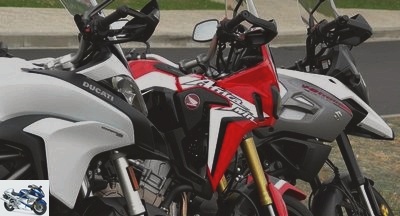
Since its release in January 2016, the Honda Africa Twin has met with a well-deserved success that arouses much envy: this year, Ducati opposes it to the unprecedented Multistrada 950 while Suzuki updates its V-Strom 1000… Site has therefore brought together these three 1000 cc trails for a new comparison.
Multistrada Vs Africa Vs V-Strom page 3: three 1000 cc trails
Of the three motorcycles assembled today by MNC, the Africa Twin is the most off-road type, first of all because of its high rear part which requires perfect mastery of the "high level circular kick" … Short legs will struggle, whether to take place on the handlebars or behind the rider.
Once the high rack has been spanned, the Honda rider is greeted by a high saddle (850 or 870 mm) and fairly thin but suitably trimmed, as well as by suspensions which sag generously under the weight of the rider, facilitating especially the access of both feet to the ground: on the tip for less than 1.80 m, on the heels for "more".
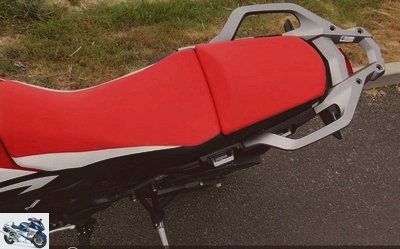
By backing up well on its long “enduro” type saddle – compared to the more “GT” style of the rivals – the driver can open the knees to 90 ° or almost, while his thighs are only very little apart by the tank. It feels like sitting on a comfortable chair !
Conversely, the handlebars of the "CRF1000" spread the arms a little more than the other two and are located a little higher. This position, far from being uncomfortable, above all makes it easier to manage the 21-inch front wheel (19 "on the other two motorcycles).
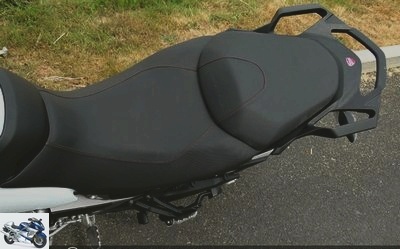
Very different, the driving position on the Ducati did not please MNC testers: admittedly, the bowl-shaped saddle is only 820 mm from the ground, it is quite soft and the rear shock absorber makes it possible to gain a few extra millimeters, making the Multistrada the most accessible motorcycle in this comparison for little ones…
But the legs – of great pilots – are found too bent once the boots are placed on the footrests! To gain a little amplitude, the rubber – full and a little slippery – can quickly be removed. Conversely, the clutch lever (not adjustable, as on the Honda) is located a little far from the handlebars and may handicap the small babes handcuffs.
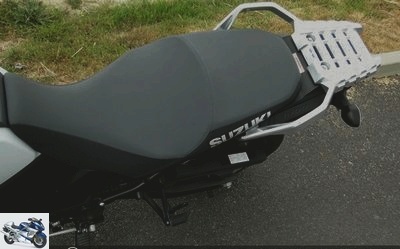
Closer to the Honda in terms of ergonomics, the Suzuki features lower handlebars, a larger tank and drier suspensions that will no doubt appeal to riders who have just stepped off a maxiroadster and are looking for a more comfortable frame over the long haul.
The pilot of the V-Strom 1000 also benefits from a saddle that is both flat and long – as on the Africa Twin – which allows him to relax his legs, and as wide as that of the Multistrada 950, therefore suitable to properly distribute the load of the butt.
The Suzuki is also the only one of the three motorcycles to have a hydraulic clutch control and an adjustable left lever: the whole is both soft, precise and placed at an optimal distance from the handlebars! The Ducati and Honda must bow, despite their pleasant "wired" clutch.
The three-twin war
The three engines are started, but we can hardly hear that of the Multistrada 950 which sounds like a 1200 … Panigale ?! Lively and roaring, the L-Twin will appeal to sports bike enthusiasts while others will certainly enjoy 5 minutes, but will be relieved to cut its whistle after a day of riding. !
At the opposite end of the spectrum is the Suzuki V-Twin, whose very large pot with its unsightly – and exposed – valve is the most discreet. Against all expectations, it is ultimately the Honda Parallel Twin that offers the best compromise: wise at idle and at low speed, it raises the tone pleasantly afterwards and even crackles a little when decelerating..
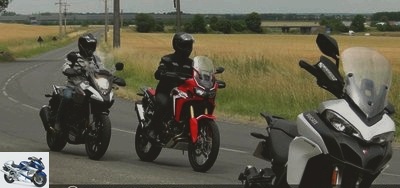
The Africa Twin continues to score valuable points at the very beginning of the ride thanks to its surprising handling and its better turning circle: 4.5 meters measured by the Motorcycle Journal on the Internet. The Ducati requires 45 cm more and the Suzuki 90, which can complicate some maneuvers in parking lots.
At low speed, the "CRF" turns out to be as agile as its two competitors, despite its more open front end and its mid-range wheelbase (2 cm more than the DL, 1.9 cm less than the Multi) … Its thinner tires undoubtedly compensate.
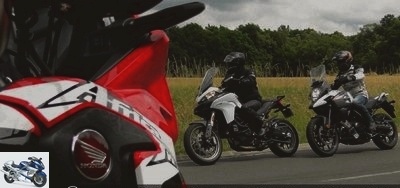
When the speed exceeds 35 km / h or so, the inertia of the 21-inch spoke rim posted in front of the – true? – Honda trail is however felt. The 19-inch spoked rims of the Ducati and Suzuki then require a little less effort on the handlebars.
On the handlebars of the Multistrada 950, there is also a small inconvenience, greater than the blink / horn inversion of the Honda: on the Ducati, the right thumb must twist to pass over the accelerator and reach the warnings, which must be pulled – and not pushed ?! – the command to the right…
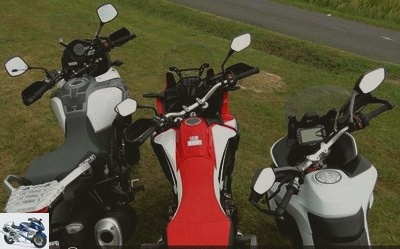
The blow is not easy to take and captures the pilot’s attention too much: watch out for the first lifts! Especially since the Ducati engine is the least disciplined of the three: we prefer to keep it above 3000 rpm so as not to rush the mechanics. We can therefore barely maintain 50 km / h in 3rd gear !
The Japanese twin cylinders are more flexible than the Italian, both agreeing to go down to 2000 rpm, including on the latest reports. The Suzuki engine however takes the ascendancy thanks to much more consistent recoveries than those of the Honda….
Valorous Ducati
"The torque of 101 Nm delivered low in revs at 4000 rpm gives character to the bike," promises Suzuki on its official website? Promise kept! "An agile, comfortable and powerful machine: here is what you need to cross the dunes … or go for the everyday!", Continues Suz ‘. And like the overwhelming majority of large-displacement trail customers, MNC remains on the asphalt.
During our tests of times in fourth, the V-Strom 1000 makes short work of the Africa Twin: between 3000 and 5500 rpm, the torque-fed V-twin humiliates the in-line twin. The L-twin, which pulls shorter, resists better and even turns in the lead when the second half of the tachometers is engaged !
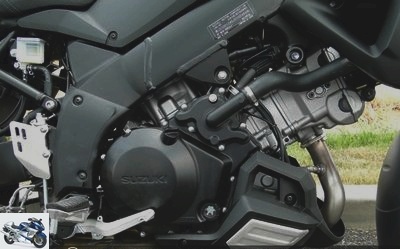
Credited with the best maximum power (113 hp), the Multistrada 950 has an astonishing extension for a trail! Like a sportswoman (MNC has remained in "Sport" mode, moreover, as responsive as it is fine), the Italian is just waiting to be whipped. The pilot can wait for the lights in the red zone to flash to upshift, which is not the case on the Suzuki.
On the V-Strom 1000 – and all the more so on this Euro 4 version -, it suffices to look only once for the red zone (9500 rpm) to declare that it is preferable to chain up gears when the needle exceeds 8000 rpm. The range of – big – performance remains wide, much higher than that of the Honda.
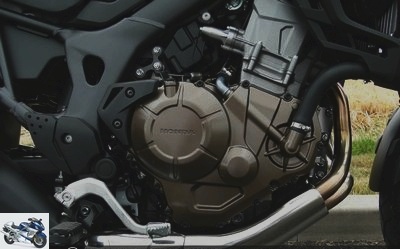
To take advantage of clear acceleration on the Africa Twin, the pilot must indeed ensure to remain between 5,000 and 8,500 rpm. And to stay in contact with his two comrades, he must imperatively drive on the lower gear. In the end, however, the character of this engine is far from unpleasant..
Wise at first – too much, some will complain – the parallel twin benefits from a pleasant revival of vigor at mid-range, amplified by the airbox and the exhaust. More full and efficient, the V-twin seems more linear. With the angrier L-twin, customers are spoiled for choice when it comes to engine. And the same goes for the cycle part !
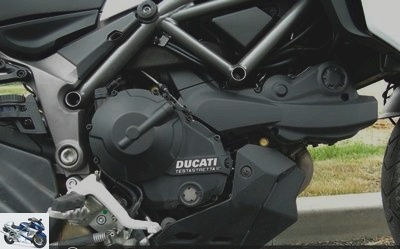
Overall, these three bikes are bluffing efficiency in the winding: today’s trails have nothing to do with the trapanels of yesteryear with poor braking and rough handling. Nevertheless, we quickly detect differences in behavior which will guide the Motonauts / customers towards one or the other of the machines….
The Suzuki shines particularly in the winding: the mass transfers are much less than on the two competitors, thus offering a much more precise touch of the road. The fork may be the least fuzzy on paper (43 mm against 45 on the Honda and 48 on the Ducati!), It guides the bike better and does not stiffen when the brakes are set on the angle..
Suzuki safe bet
Note in passing that the Bosch ABS of the V-Strom 2017 is combined with an inertial unit – the famous "IMU", essential on Superbikes – supposed to reduce the risk of falls when cornering. On dry and clean roads, you can actually feel the system regulating piston pressure when you apply – too much – the full-angle front brake. To be tested in the wet !
When exiting a curve, the greater rigor of the Suzuki’s rear axle allows for more sporty driving. It is in the rider’s interest to move forward on the saddle as far as possible in order to load the front and keep the steering function of the wheel … Yes, yes, it is more practical !

Despite its very long travel suspensions (230 and 220 mm), the Africa Twin is absolutely not lost on the road: like the Ducati, the Honda also erases the imperfections of the bitumen better than the Suzuki. The slider of the two "Reds" deliberately points more towards comfort than towards sport.
On the Rouge de Bologne, we regret that the shock absorber struggles to withstand the assaults of its hot Testastretta and stabilizes its rear end quite poorly on the bumpy. By accelerating hard – very hard – the front axle becomes considerably lighter and the handlebars shake a lot: it is not easy to open wide on small bumpy roads !

The Tokyo Rouge on the other hand is perfectly homogeneous on deformed pavement and more pleasant to (badly) drive … The lower constraints imposed by the parallel Twin make the work of the Honda cycle part easier, of course, but we must salute the quality of its suspensions.
When braking, we note that the Africa Twin’s fork first sinks in generously and then gradually slows down the dive before returning calmly to its initial position. We quickly integrate its operation and we attack more readily than at the controls of the Ducati, decidedly more turbulent.
Honda upgrading
But even at reasonable speed, the Multistrada 950 is less pleasant to drive. The fault, once again, to its disconcerting ergonomics: to get the brake pedal, the right ankle must accommodate the bulky clutch housing. So we brake from behind with the foot across…
No problem on the side of the Honda which has the best rear brake of the trio: the pedal is perfectly accessible and the power can be finely controlled, which allows the bike to sit on hard braking. You can also do without the front brake in "cushy" use, which prevents any diving of the motorcycle … and will please "granny" sitting behind !

With its pedal still a little too hard and its power behind, the rear brake of the V-Strom 1000 is much less satisfactory. Quite the opposite of its front brake which is the more straightforward of the three: Tokico calipers offer more bite than Honda’s Nissins and tighten their discs more consistently than Ducati’s Brembos.
Ideal for comparing acceleration, testing road holding and testing the brakes, the summer driving conditions and ideal for our comparison "unfortunately" complicate the study of ABS and traction control. The cleanliness of the roads – thank you for the showers and the DDE – and the good grip of the tires too !
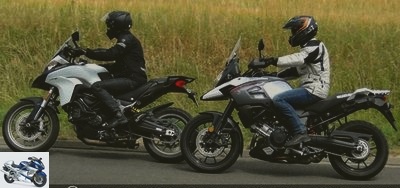
Last winter, in the R1200GS Vs Africa Twin Vs Tiger 800 showdown, Honda’s rear tire grip losses had dampened MNC’s enthusiasm somewhat. This time, on hot and dry tarmac, the original Dunlop Trailmaxs only lacked grip on rare occasions. The Ducati’s Pirelli Scorpion Trail II and the Suzuki’s Bridgestone Battlewing never triggered the traction controls..
Another subject of study that will captivate potential buyers at least as much: the fast lane! Because if the manufacturers cut their trails for rocky or sandy rally raid specials, they know full well that the long connections on motorways and national roads will also be – above all ?! – in the program.
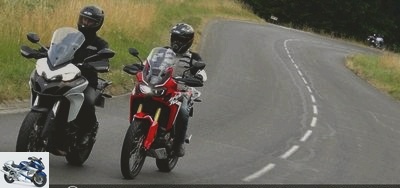
It is for this reason, for example, that the handlebars of the Multistrada 950 "were mounted on anti-vibration mounts which attenuate vibrations". Le Journal moto du Net approves this decision, since the beats of the L-Twin are almost imperceptible at the level of the hands.
On the other hand, crackles appear in the buttocks from 110 km / h and become annoying when the motorcycle stalls at 130 km / h meter (just below 5250 rpm). We regret again that the bowl-shaped saddle – which already bends the legs quite a bit – prevents you from changing position.
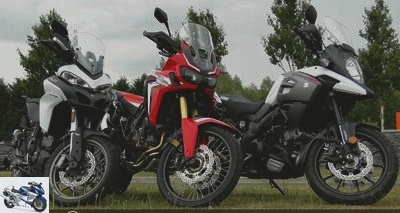
On the V-Strom 1000, the weights at the end of the handlebars do not block the passage of ants that invade the hands when cruising at 130 km / h, or just above 4500 rpm in 6th gear. Finally, on the Africa Twin, the engine turns about 250 revs higher and only distills tiny crackles in the handlebars..
Non-adjustable, the Honda bubble protects two thirds of the helmet and half of the shoulders. Its ingenious cutouts avoid any vacuum or draft effect. On the Ducati, the screen in the high position offers similar protection. Posted close to the pilot, it also has a good comfort zone.
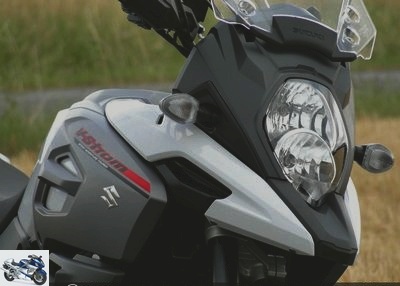
Thanks to its "windshield", the Suzuki completely isolates the shoulders and three quarters of the helmet. But for that to happen, the screen must be pushed forward as much as possible, so much so that swirls creep into the back and around the helmet. Not obvious that on very long journeys, the Suz ‘pilot wears out less quickly…
Note that in rainy weather, the Ducati does not sufficiently protect its rear: the Multistrada 950 has not only abandoned the single-sided arm of the 1200, but also dropped its offset mudguard … At the slightest downpour, even at the slightest puddle, the Italian spits you in the back. This does not happen with respectful Japanese.
Spree for two
So as not to have the jacket repainted, MNC therefore advises the Ducati rider … to take a passenger on board! The latter will also have to withstand the vibrations of the engine – amplified along the rear loop -, the soundtrack too present and a slight discomfort in the right foot (rubber of the case support). On the other hand, the triangular cutout of the Ducati handles is well seen and the field of vision is excellent..
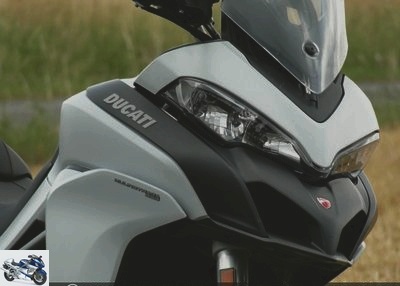
Difficult to ride – as we have already pointed out – the Africa Twin then gives the "co-pilot" a warm welcome: large handles placed just behind the hips, accessible tank to counter heavy braking, good visibility by shifting slightly and vibrations limited. In addition, the suspensions of the Honda freeze less than those of the Ducati.
It is ultimately the V-Strom 1000 which wins the duo competition: the saddle is more accessible and wider than on the Honda, the vibrations are less than on the Ducati, the visibility is as good and the rubber ridged on the rests. feet provide perfect grip. The passenger is satisfied, as is the pilot who hardly has to adapt his driving.

Apart from a few kilometers in duo, Site covered most of these 450 km of solo testing, without luggage and at legal speeds … while sometimes allowing himself a few maximum accelerations! Proof of our "good driving": our motorcycles consumed less than 6 liters per 100 km.
With an average consumption calculated by MNC at the pump of 5.5 l / 100 km, the Africa Twin is the most fuel-efficient. This allows it to cover the same distance with a full tank (18.8 liters) as the Multistrada 950, although it has a 20 l tank (5.8 l / 100 km). In terms of autonomy, the Honda and the Ducati can cover a little over 340 km. The V-Strom 1000, barely more greedy than the Africa (5.6 l / 100 km), comes close to 360 km with its 20 liters.
Verdict: impossible to be wrong !
In the end, the verdict of this new MNC comparator is crystal clear: it is impossible, after their own concession test, for potential buyers to make a mistake in their choice! The Multistrada 950 is clearly intended for those who drool in front of the 1200 but do not have the funds – or the neck … – necessary to afford the big Ducati.
Its angry L-Twin, its clean lines, its comfortable suspensions – a little too flexible … -, its "special" ergonomics and its bowl saddle classify it apart in the family of 1000 cc trails. Aficionados will love … despite the highway vibes ?
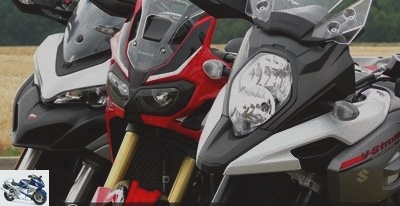
While the Multi is separate, the Africa Twin and the V-Strom 1000 fight and Site struggles to decide between them … Undoubtedly, basically, because these two Japanese 1000 cc trails with similar characteristics ultimately have two very distinct characters.
The advantage for customers, ink once, is that they will not hesitate between the two: those who want to work on the road without fatigue or stress – it has ABS on the corner! – will opt for the Suzuki, its engine full of torque, its rigorous cycle part and its lighter invoice.
More charismatic and pretty, better finished and able to frolic on country roads, the Africa Twin will be adopted by bikers with a slightly better stocked wallet. Less powerful than its two rivals, it does not lack character or comfort. Make your choice !
Related articles
-
Comparison test Multistrada 950 Vs Africa Twin Vs V-Strom 1000: right on target Since its release in January 2016, the Honda Africa Twin has met with a…
-
Comparison test Multistrada 950 Vs Africa Twin Vs V-Strom 1000: right on target Since its release in January 2016, the Honda Africa Twin has met with…
-
Comparison test Multistrada 950 Vs Africa Twin Vs V-Strom 1000: right on target Since its release in January 2016, the Honda Africa Twin has met with a…
-
Comparative test of sports trails: Multistrada DVT Vs S1000XR Vs Versys 1000 Before, sports motorcycles were stripped to become vitamin roadsters. From…
-
Comparative test of sports trails: Multistrada DVT Vs S1000XR Vs Versys 1000 Before, sports motorcycles were stripped to become vitamin roadsters. From…
-
Comparison test Multistrada 950 Vs Africa Twin Vs V-Strom 1000: right on target Since its release in January 2016, the Honda Africa Twin has met with a…
-
Africa Twin 1100 Vs V-Strom 1050 XT: Honda or Suzuki maxitrail, which is the stronger ? Two major 2020 novelties compete on Site: the Africa Twin 1100…
-
Comparative test Tuono V4RR Vs GSX-S1000 Vs MT-10: 1000 fires ! Launched this year by Yamaha, the MT-10 intends to shine in the 1000 cc roadsters…
-
Africa Twin vs Tiger 800 XCX and R1200GS comparison test: Honda makes the big difference Sleek and smelling the ‘real’ all-terrain, the new Africa Twin…
-
Africa Twin 2018 test: looking for a new model, Adventure Sports if affinities Honda successfully revived the Africa Twin line in 2016 with a finely…